Trilostane
Ellen N. Behrend, VMD, PhD, DACVIM, Auburn University

Trilostane is a synthetic steroid analog that inhibits the adrenal enzyme 3b-hydroxysteroid dehydrogenase.
Overview
Trilostane suppresses production of progesterone and its end products, including cortisol and aldosterone.
Additional enzymes, (eg, 11b-hydroxylase, 11b-hydroxysteroid dehydrogenase) may also be affected.
Treatment Protocol
Clinical doses currently being used are lower than originally believed necessary.1
The current FDA-approved labeled dose is 2.2-6.7 mg/kg administered once a day.2
The author recommends starting treatment as close as possible to the low end of that dose range.
Large dogs (ie, >25 kg body weight) generally require lower doses on a per-kilogram basis to control clinical signs.3
Despite label recommendations for once-a-day administration,2 trilostane may begin to lose its effectiveness 8 to 10 hours after administration.4
Administration twice a day delivered good efficacy and may increase chance of remission in dogs with pituitary-dependent hyperadrenocorticism (HAC).5
The need to increase the frequency to 3 times a day has been reported in some dogs.6
If twice a day results in ideal or acceptable cortisol concentrations but clinical signs are not controlled, 3 times a day should be considered.
The author likewise recommends administration twice a day in all dogs with HAC.
This protocol is especially indicated in patients for which breaks in control of HAC could be detrimental if the drug effects wear off (eg, dogs with concurrent diabetes mellitus or serious complications of HAC, such as proteinuria or hypertension).
Trilostane should be given with food to increase absorption from the GI tract.<sup2 sup>
Use of the trademark product Vetoryl (Dechra) is recommended by the author.
Compounded products can contain 40% to 150% of the labeled amount and may have variable dissolution properties.7
The bioavailability and pharmacokinetics of compounded trilostane are unknown, as is stability of liquid formulations.7
Monitoring
Adrenocorticotropic hormone (ACTH) stimulation testing is necessary for monitoring patient response to therapy.8
Alternatives (eg, baseline cortisol, endogenous ACTH, cortisol:ACTH ratio, urinary cortisol:creatinine ratio) have been assessed and were found to be unreliable.8
The test should start 2 to 6 hours after drug administration; the ideal interval is unknown.
It is important that the interval always be the same for an individual patient (eg, if the first test is done 5 hours postadministration, all subsequent tests should also start 5 hours postadministration).9
Variations in sampling time (ie, start time of ACTH stimulation test relative to drug administration) of 2 hours can result in significant differences in cortisol levels and may influence dose and/or frequency recommendations.9
The first ACTH stimulation test should be performed after 10 to 14 days of treatment or if decreased appetite, vomiting, diarrhea, listlessness, or normalization of water intake occurs.1
Because the full effect of the drug may not be seen for ≈30 days, the first recheck is to ensure against overdosing.
The dose should not be increased at the first recheck but should be decreased if serum cortisol concentrations are too low.
The ideal cortisol concentrations pre- and post-ACTH testing are ≈1-5 µg/dL (30-150 nmol/L).
A cortisol concentration of up to ≈9 µg/dL (250 nmol/L) post-ACTH testing is considered acceptable if the patient is doing well and clinical signs of HAC are controlled.8
Dose adjustments (ie, increases and decreases) based on ACTH stimulation test results and clinical signs will need to be made over time in most patients.
Adverse Effects
In most patients, adverse effects are relatively mild and include lethargy, weakness, decreased appetite, vomiting, and diarrhea.2 Fatality has occurred but is rare.2
It is important to differentiate minor adverse effects from hypocortisolism, which causes the same clinical signs.
ACTH stimulation testing may be necessary.
Because cortisol is a natural antiinflammatory, when concentrations are decreased by trilostane administration, concurrent inflammatory conditions (eg, osteoarthritis) can worsen.
Theoretically, trilostane effects should be reversible within 1 to 2 days; however, suppression of cortisol secretion can last weeks to years.10-12
Adrenal necrosis is possible, to the extent that aldosterone secretion becomes deficient and complete hypoadrenocorticism results.<sup13,14 sup>
Aldosterone secretion can be suppressed independently of cortisol, potentially leading to signs of hypoaldosteronism.15
If hormone deficiency occurs, trilostane administration should be stopped until adrenocortical recovery is documented by ACTH stimulation testing and electrolyte measurements.